Seven effective at-home recovery tools can help you tackle muscle soreness head-on. Start with a foam roller to break up muscle knots and improve circulation. Use hot and cold therapy tools like ice packs and heating pads to reduce inflammation and promote blood flow. Add compression gear to speed up recovery and minimize swelling. Consider a massage gun for targeted muscle relief and a TENS unit for pain management. Incorporate stretch straps and resistance bands for flexibility work, and try infrared therapy devices for deep tissue healing. Let's explore how each tool can maximize your recovery potential.
Foam Rolling Essential Techniques
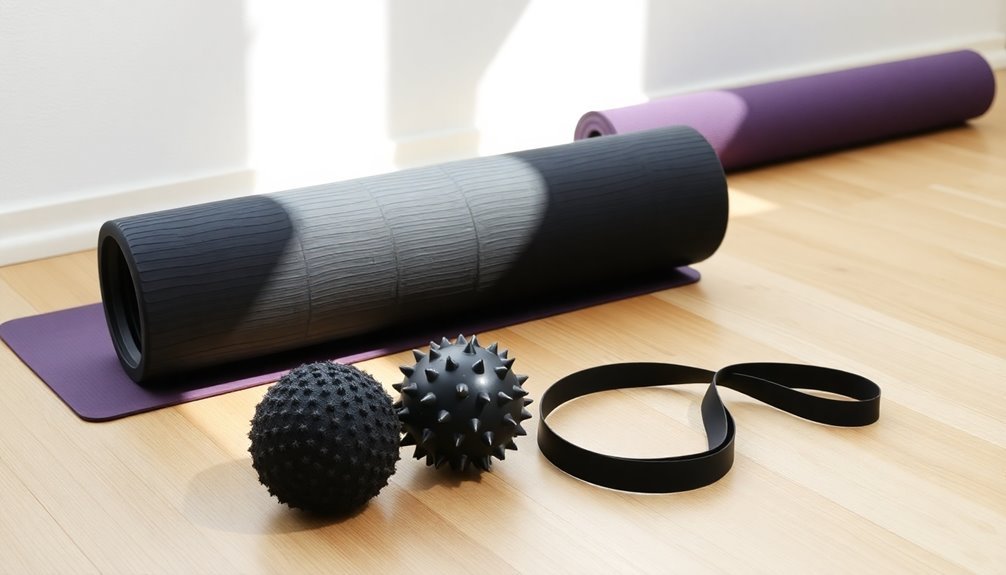
Getting started with foam rolling requires understanding both the equipment and proper techniques to maximize its benefits. When selecting a foam roller, consider starting with a soft or medium-density option if you're new to the practice, as firmer or textured rollers can be intense for beginners.
You'll want to work your way up to denser materials as your muscles adapt to the pressure. Regular practice aids in breaking up muscle adhesions and improving circulation to affected areas.
To roll effectively, focus on major muscle groups like your calves, quadriceps, hamstrings, IT band, and glutes. Move slowly and deliberately across each area, pausing for 20-30 seconds when you find particularly tight spots. Remember to keep the roller away from bones and joints to prevent injury.
You can adjust the pressure by shifting your body weight – the more weight you place on the roller, the deeper the massage.
For best results, incorporate foam rolling into your routine 3-4 times weekly, especially after runs or as part of your warm-up. Combine rolling with stretching exercises for thorough muscle recovery.
Always listen to your body and adjust the pressure based on your comfort level, being careful not to overwork any single area.
Hot and Cold Recovery Methods
When it comes to soothing your sore muscles, both hot and cold therapies offer unique recovery benefits.
Cold therapy excels at reducing inflammation and pain within the first 24 hours after exercise, while heat works better for immediate muscle damage recovery and improving blood flow to tight muscles.
You'll get the best results by using cold water immersion at 11-15°C for up to 15 minutes when dealing with acute soreness, or applying heat for 15-20 minutes when targeting muscle stiffness after the initial inflammation has subsided. Research shows that athletes who use either heat or cold therapy experience only 4% strength loss compared to those who skip treatment altogether.
Temperature Benefits For Muscles
After an intense workout, understanding temperature therapy can make the difference between a quick recovery and prolonged muscle soreness. Timing plays a vital role in choosing between hot and cold treatments for the best results.
You'll want to use heat therapy immediately after exercise, as it's superior for instant muscle recovery and relaxation. Heat promotes blood flow and helps prevent elastic tissue damage, making it particularly effective for strength recovery and chronic pain relief. The release of endorphins during cold exposure can help create a positive mood during recovery.
Cold therapy, however, becomes your best ally 24 hours post-exercise. It's especially effective at reducing inflammation, providing pain relief, and minimizing muscle damage. If you're an athlete focusing on sprints, you'll find that cold water immersion can help restore your performance within 24-48 hours.
For the best results, you might want to think about combining both methods. While cold therapy isn't as effective for improving muscle strength or endurance (showing only 33% and 11% improvements respectively), alternating between hot and cold treatments can help reduce exercise-induced muscle pain more effectively than using either method alone.
Remember that ideal cold therapy temperatures can vary between individuals, ranging from 0 to 15 degrees Celsius.
Hot-Cold Application Techniques
Throughout your muscle recovery journey, you'll discover that mastering hot and cold therapy techniques can substantially impact your healing time.
When you're dealing with immediate post-exercise soreness, start with cold therapy to reduce pain and inflammation. Always remember to wrap cold packs in towels to protect your skin from direct contact. Apply cold packs or use ice baths for 15-20 minutes to numb pain receptors and minimize swelling.
For strength recovery and muscle flexibility, switch to heat applications once the initial inflammation subsides. You'll find that hot tub immersion or heating pads increase blood flow and relax your muscles effectively. Heat therapy works particularly well for chronic muscle stiffness and maintaining long-term flexibility.
To maximize your recovery benefits, try contrast therapy by alternating between hot and cold treatments. You can create your own contrast bath system at home using a hot tub and cold tub sequence. This combination approach helps reduce muscle strength loss while promoting faster healing.
If you don't have access to full immersion equipment, you can achieve similar results using heating pads and cold packs alternately. Don't forget to integrate compression features with your cold therapy sessions for enhanced recovery results.
Compression Gear Benefits
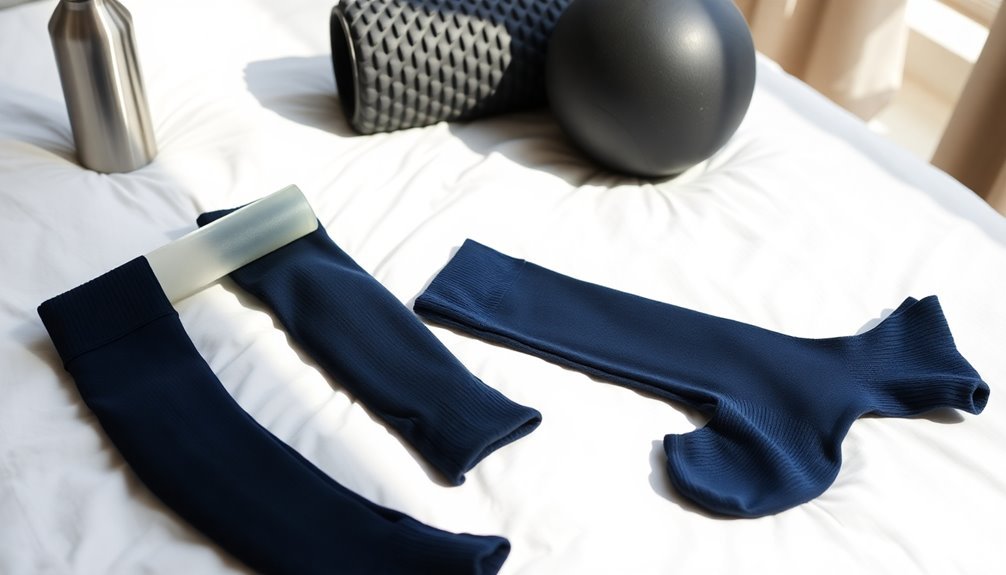
The benefits of compression gear extend far beyond simple muscle support. By applying consistent pressure to your muscles, compression garments substantially reduce delayed onset muscle soreness (DOMS) and help minimize post-workout inflammation.
When you wear compression gear, it improves blood circulation and accelerates the removal of waste products from your muscle tissues. The graduated compression design helps move depleted blood back to your heart, while also reducing lactic acid buildup during exercise. Anatomical padding in compression gear helps prevent friction and discomfort during prolonged activities.
While compression won't boost your performance during workouts, it's particularly effective at speeding up recovery after intense training sessions.
You'll notice additional benefits like better temperature regulation and reduced muscle vibrations during exercise. Whether you're strength training or cycling, compression gear can help prevent blisters and minimize muscle soreness.
While some benefits might be influenced by the placebo effect, research consistently shows that compression gear reduces perceived muscle pain and soreness. For best results, focus on wearing compression garments during and after workouts, rather than expecting performance improvements during exercise.
Self-Massage Tools and Techniques
Self-massage tools provide a practical solution for treating sore muscles in the comfort of your home. Tools like the Body Back Buddy and Theracane Massage Cane target specific trigger points, while foam rollers help release tension in larger muscle groups. The Body Back Buddy features 11 different knobs designed to effectively target various muscle groups and pressure points.
For foot-related issues like plantar fasciitis, specialized foot rollers can provide targeted relief through rolling motions.
To maximize the benefits of these tools, you'll want to apply sustained pressure to trigger points for 10-30 seconds, allowing the muscle to release and blood flow to increase.
When using massage sticks on your legs, work with up and down movements to effectively release major muscle groups. For hand and neck relief, use circular motions with your fingers to target specific areas of tension.
You'll find the best results by incorporating self-massage twice daily into your routine. When selecting tools, consider their specific purpose and durability. Look for ergonomic designs that you can easily use on your target areas.
Professional-grade options like the Body Back Buddy offer versatility for various body parts, while specialized tools like the Theraband Roller focus on specific regions.
Infrared Light Therapy Equipment
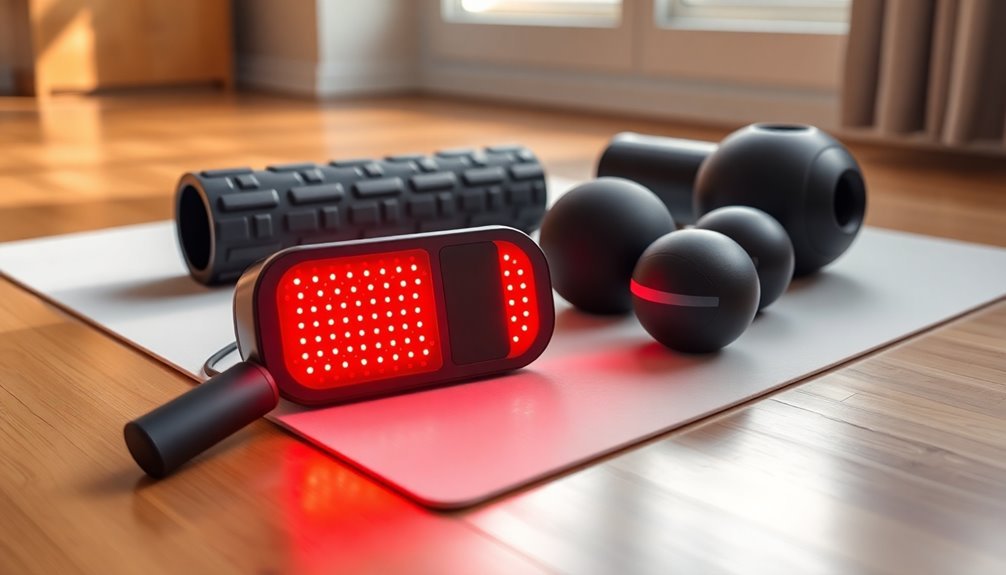
While self-massage tools offer hands-on relief, infrared light therapy equipment takes muscle recovery to a new level through advanced technology. These devices, ranging from handheld wands to full-body blankets, emit specific wavelengths of infrared and red light that penetrate deep into your muscle tissue, reducing soreness by up to 60% and substantially lowering inflammation markers. The specific wavelengths of 630-700 nanometers are most effective for penetrating muscle tissue.
You'll find various options to suit your needs, including portable, USB-rechargeable devices for on-the-go recovery and larger blankets that provide full-body treatment.
When using these tools, you'll want to maintain a distance of 6-12 inches from your skin and limit sessions to 10-30 minutes for maximum results. Don't forget to stay well-hydrated, as the therapy can increase your body temperature.
The effectiveness of infrared light therapy isn't just marketing hype – it's backed by solid research. Studies show it's particularly effective at accelerating recovery from muscle damage, helping restore strength and movement 1-3 days faster than usual.
You'll benefit from improved circulation, better oxygen delivery to muscles, and faster removal of metabolic waste products, making it a valuable addition to your recovery toolkit.
Recovery-Focused Stretching Routines
Successful muscle recovery demands a strategic approach to stretching that goes beyond basic flexibility work. When your muscles are sore, incorporating gentle stretches for 12-second intervals can boost blood flow and help break down lactic acid buildup. These stretches are most effective during the peak soreness period between 24 to 72 hours after exercise.
You'll want to focus on static stretches post-workout, while saving dynamic movements for your warm-ups.
Your recovery-focused stretching routine should include these essential elements:
- Hamstring and calf stretches to target lower body soreness, performed while lying down or standing
- Inner thigh and buttock stretches to release tension in your hip area and improve mobility
- Thigh stretches that you can easily modify based on your current flexibility level
- Gentle movements combined with diaphragmatic breathing to enhance overall relaxation
- Strategic use of tools like resistance bands to amplify your stretching effectiveness
To maximize your results, pair these stretches with proper hydration and adequate rest periods. You'll find that immediate post-workout stretching is particularly effective for reducing muscle soreness.
For additional support, consider incorporating tools like foam rollers or percussion massagers to complement your stretching routine.
Therapeutic Mobility Exercises
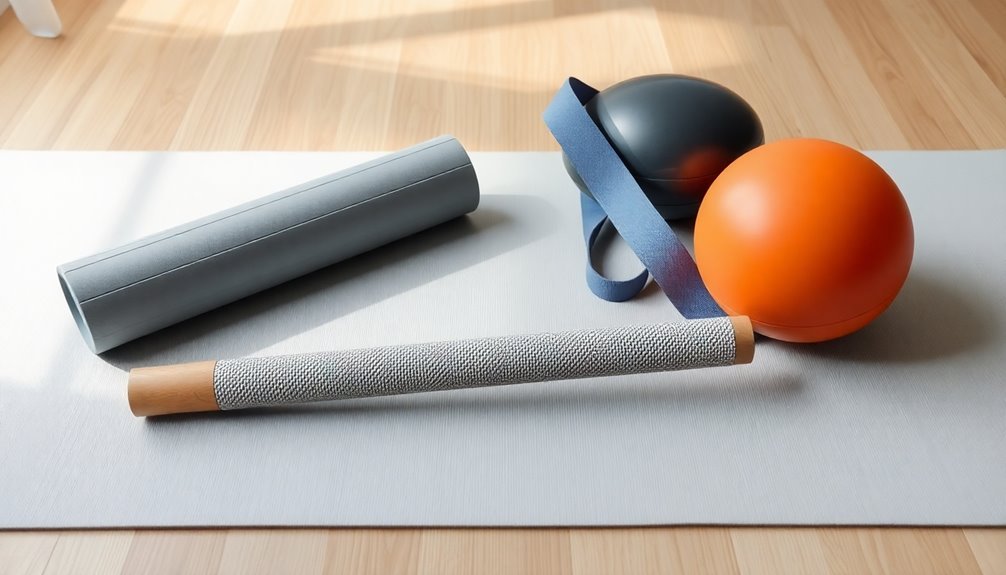
You'll find significant relief from sore muscles by incorporating targeted rolling movements that enhance joint mobility and reduce stiffness.
Dynamic movement patterns, such as shoulder circles and spinal rotations, help your body restore natural ranges of motion while promoting better muscle function.
Using tools like foam rollers and massage balls lets you effectively release tight muscle groups, making them essential components of your recovery routine.
Rolling for Joint Health
Through targeted rolling techniques and therapeutic mobility exercises, you can remarkably improve your joint health and reduce muscle soreness. Using tools like foam rollers and massage balls, you'll target specific muscle groups while applying controlled pressure to release tension and enhance flexibility.
When you roll regularly, you'll experience improved range of motion, decreased stiffness, and better overall joint mobility.
To maximize your rolling routine's effectiveness, focus on these key techniques:
- Apply moderate pressure on sore spots for 20-30 seconds using foam rollers
- Use circular motions with massage balls to reach smaller, tight areas
- Target major muscle groups including calves, quads, hamstrings, and upper back
- Adjust pressure based on your comfort level and pain tolerance
- Combine rolling with stretching and strengthening exercises
For superlative results, integrate rolling into your regular recovery routine by pairing it with bodyweight exercises, yoga, or Pilates. You'll notice improved balance, reduced pain, and enhanced muscle recovery when you maintain consistency.
Remember to focus on proper form and technique, and don't hesitate to seek guidance from a physical therapist for a personalized approach to joint health.
Dynamic Movement Patterns
Dynamic therapeutic exercises transform conventional stretching into powerful movement patterns that retrain your muscles and nervous system. These movements tap into your brain's neuroplasticity, creating lasting improvements in mobility and function while helping your sore muscles recover more effectively.
When you perform dynamic movements, you're actively engaging your muscles against gravity, which helps improve your balance, posture, and overall motor control. Unlike static stretching, dynamic patterns encourage your body to move through its full range of motion, leading to better flexibility and reduced muscle tension.
You'll notice that these exercises become more automatic with practice, making them increasingly effective for muscle recovery.
To get started, begin with basic movements that match your current abilities, then progressively challenge yourself with more complex patterns. You'll want to focus on smooth, controlled motions that target your specific areas of soreness or limitation.
Remember that consistency is key – regular practice will help your muscles and nerves work together more efficiently. While you can perform these exercises at home, it's worth getting initial guidance from a qualified professional to guarantee you're using proper form and choosing appropriate movements for your needs.
Release Tight Muscle Groups
Muscle-release exercises offer targeted relief for tight, overworked tissues while promoting better mobility throughout your body.
When you're dealing with muscle tension, combining different therapeutic approaches can help you recover faster and prevent future discomfort.
You'll find that tools like foam rollers, massage sticks, and resistance bands enhance your mobility work, while exercises like shoulder circles and hip rotations restore your range of motion.
- Try cat-cow stretches to improve spinal flexibility and release back tension
- Use contract-relax stretching to signal your muscles to let go of chronic tightness
- Incorporate PNF techniques to retrain your muscles for better coordination
- Practice child's pose to decompress your spine and lengthen tight back muscles
- Add foam rolling sessions to break up adhesions in problematic areas
For maximum benefit, pair these exercises with neuromuscular re-education movements. You'll want to focus on dynamic stretching that mimics your regular movement patterns, especially when targeting specific muscle groups.
Consider using a TENS unit for particularly stubborn areas, as electrical stimulation can help relax persistent muscle tension while you work through your mobility routine.
Frequently Asked Questions
How Long Should I Wait After Exercise Before Starting Recovery Techniques?
You should start your recovery techniques within 10 minutes after exercising. Don't wait too long – begin with a cool-down period of 5-10 minutes, followed by hydration and post-workout nutrition.
Can I Use Multiple Recovery Tools Simultaneously for Better Results?
Yes, you can combine tools like foam rolling with compression garments or massage guns for enhanced recovery benefits. Just make sure you're comfortable and safe when using multiple tools, and listen to your body's response.
What Recovery Tools Are Safe to Use During Injury Rehabilitation?
During injury rehab, you'll want to stick with gentle tools like ice packs, compression garments, and foam rollers. Always check with your healthcare provider first to confirm they're appropriate for your specific injury.
How Often Should I Replace or Maintain My Recovery Equipment?
You'll need to inspect your recovery tools monthly, clean them after each use, and replace them based on manufacturer's guidelines, typically every 1-2 years depending on usage frequency and visible wear patterns.
Are Budget-Friendly Alternatives as Effective as Premium Recovery Tools?
You'll find budget-friendly tools like foam rollers and lacrosse balls can be just as effective for basic recovery needs. While premium tools offer extra features, they're not essential for achieving good results in muscle recovery.
In Summary
Taking care of your muscles doesn't require expensive spa treatments or professional massages. You'll find these seven recovery tools are effective, budget-friendly ways to manage soreness at home. Whether you're using a foam roller, compression sleeves, or trying infrared therapy, consistency is key. Make recovery part of your daily routine, and you'll notice improved mobility, reduced pain, and faster bounce-back after tough workouts.

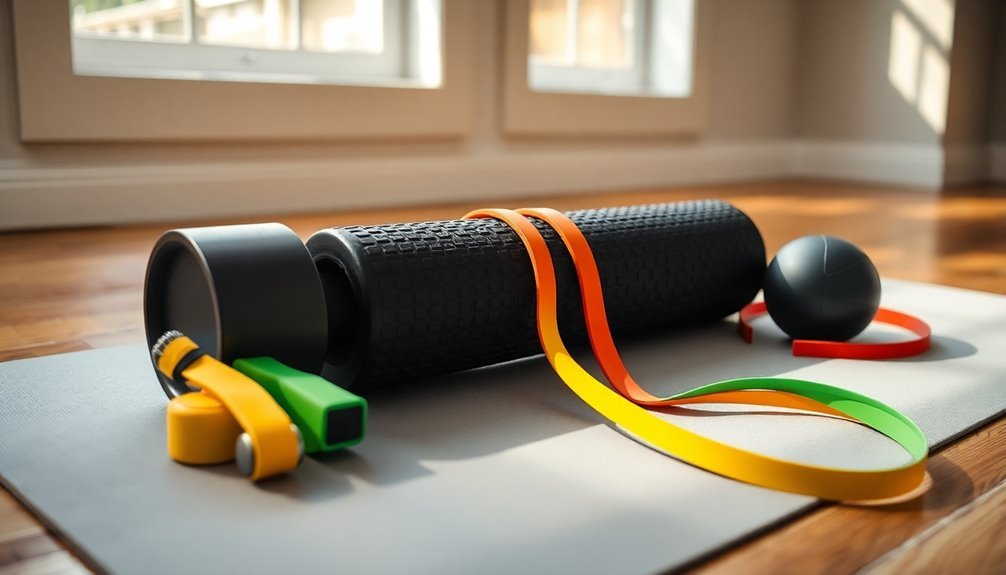



Leave a Reply